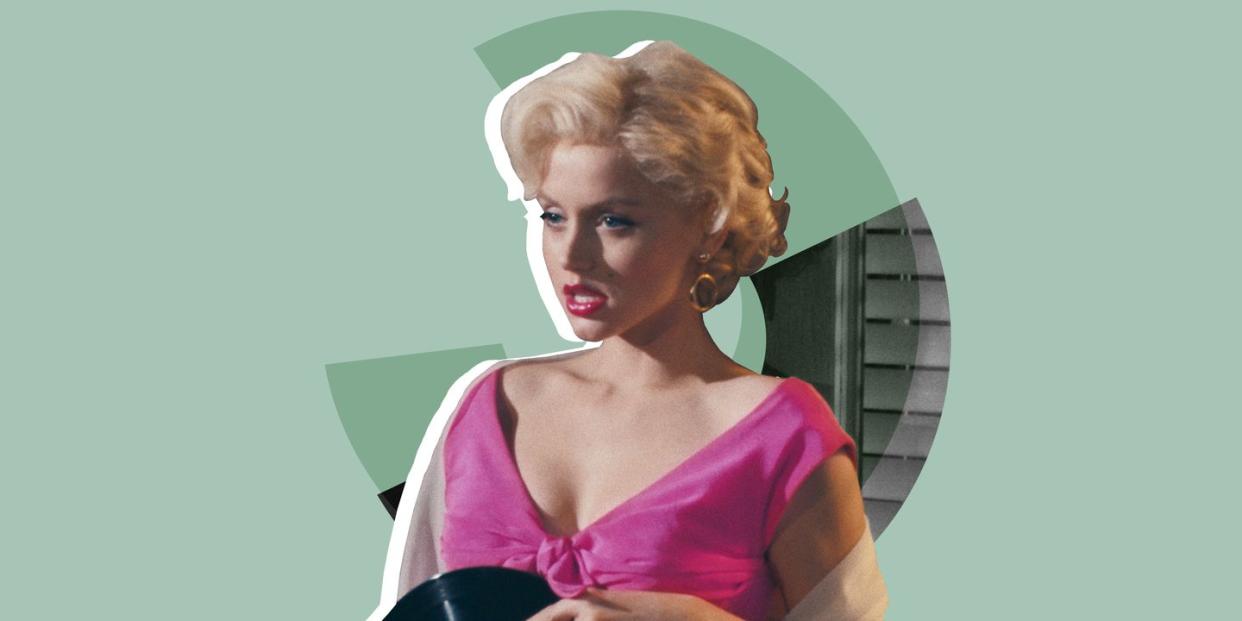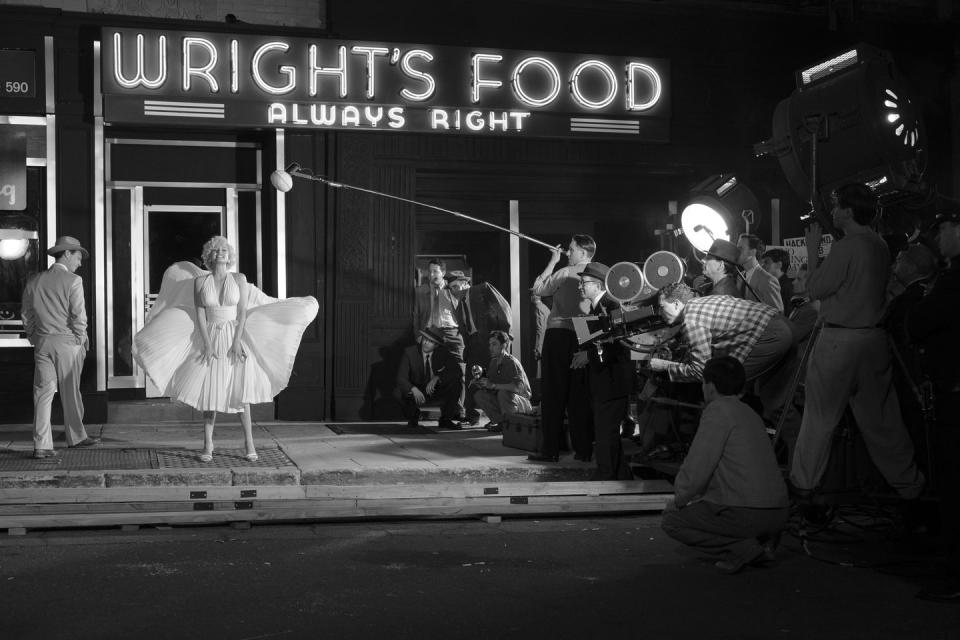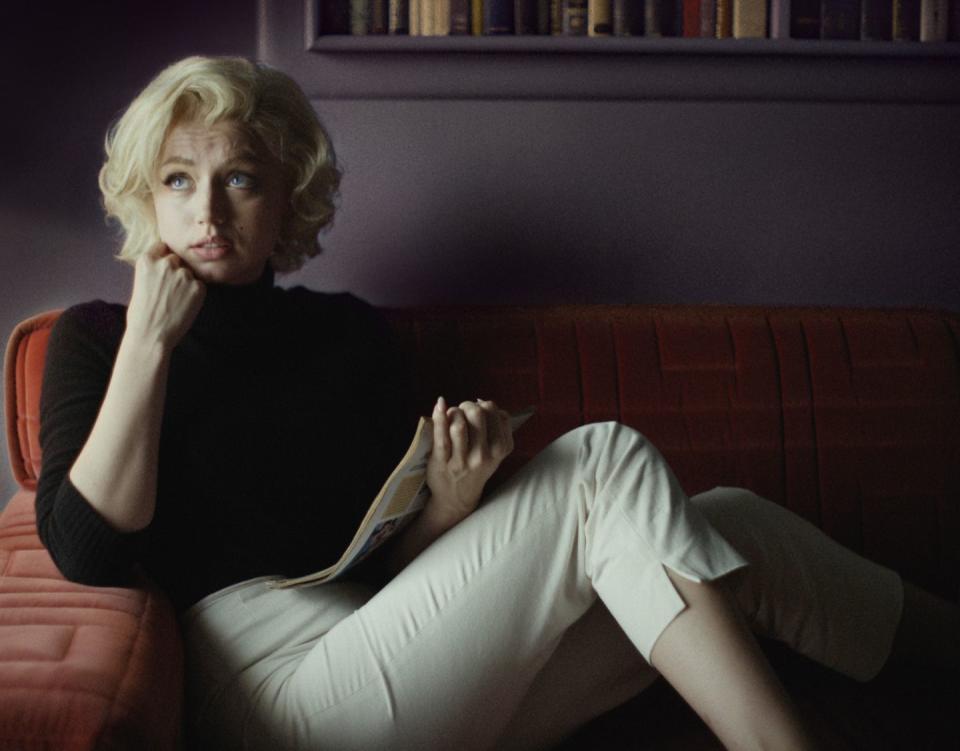What 'Blonde' Misunderstands About Marilyn Monroe

- Oops!Something went wrong.Please try again later.
- Oops!Something went wrong.Please try again later.
"Hearst Magazines and Yahoo may earn commission or revenue on some items through the links below."
Growing up, I combed my parents’ bookshelves for anything that contained pictures of naked women. Unfortunately, most of my father’s books only had words—and my mother’s were in French. There were a few volumes, however, that offered a desperate youngster some titillation—The Illustrated Beatles featured a racy picture of Lovely Rita, meter maid, and some cute cartoon breasts; a history of burlesque offered some grainy black-and-white images that were close to exciting; and The Films of Marilyn Monroe provided some lascivious shots of Monroe, though none of her more famous nudes.
I encountered Marilyn’s racier pictures in middle school when my twin sister went on a jag reading about old movie stars such as Vivien Leigh and Lauren Bacall. She gobbled up our mother’s paperback copy of Bacall’s stellar memoir, By Myself, and first encountered Monroe’s story in a TV documentary. We somehow got it on videotape and it was in heavy rotation for a long time.
My sister collected a slew of Marilyn picture books—including photography by Eve Arnold and Bert Stern—and text from Gloria Steinem and Norman Mailer. I looked through them, of course, and appreciated the power of Monroe as a photographic subject, even an erotic one, but I wasn’t drawn to her. Everything about her was too much. And I didn’t get Monroe as an actress—having been weened on Tina Louise’s secondhand impression from Gilligan’s Island, I didn’t yet know that Monroe’s breathy sex goddess persona was a put-on, the conscious styling of a nimble comic actress.
By then, Marilyn had been dead two decades, and what we knew of her was the stuff of myth, interpreted through the Warhol celebrity machine. Fame eviscerated her and animated her legend.
“Who knows what to think about Marilyn Monroe or about those who turn her sickness to a metaphor?” Pauline Kael wrote in her 1973 review of Norman Mailer’s picture book, Marilyn. “I wish they’d let her die.”
Almost fifty years later, the cliched Marilyn legend is told with a solemn if hallucinatory gothic flair in Blonde, the interminable new Netflix movie directed by Andrew Dominik, staring Ana de Armas as Monroe. Based on Joyce Carol Oates’s 1999 novel Blonde, this the Marilyn myth as a horror movie: orphan, victim, prey; raped, beat up, doomed. An all-American nightmare. In the novel, Oates provides a useful disclaimer (followed by thoughtful biographical recommendations): “Blonde is a work of fiction. While many characters portrayed here have some counterparts in the life and times of Marilyn Monroe, the characterizations and incidents presented are totally the products of the author’s imagination. Accordingly, Blonde should be read solely as a work of fiction, not as a biography of Marilyn Monroe.”
This goes double for the miserabilist Netflix adaptation, which should not be regarded as biography, though it might be tempting to take it as such because of its meticulous visual detail. Blonde is stylish and controlled—then the characters speak and it is leaden. Because the movie is almost entirely humorless, we are left with camp without pleasure—Showgirls bad without being Showgirls fun-bad. Blonde is too solemn, technically accomplished, and deadly earnest for anything like fun. It much prefers punishment.
You may have heard that Blonde is the first Netflix film with an NC-17 rating, but what makes it NC-17 is sex mixed with brutality, not just explicit sex. This is a movie that wants to excite you and make you feel rotten, so we can truly understand what it was to be Marilyn, a piece of meat. In an elaborate re-creation of the subway grate scenes in The Seven-Year Itch, Monroe’s skirt flies up, and we get a Hieronymus Bosch-like gallery of leering men, writers, photographers, and technicians, as well as a montage of slow-motion replays of her skirt flying up, from all different angles. And yes, they do show us Marilyn’s crotch and her panties. Blonde wants to have its cheesecake and eat it too.

The look is almost unceasingly self-conscious and impressive, and the movie often has the feel of a perfume ad. The hair-styling, costumes, set decoration, and production design are superb. Cinematographer Chayse Irvin’s visual style covers the waterfront—hyper-realistic and intimate, then arch and dramatically theatrical. If many of the scenes seem somewhat familiar, it’s because they are based on famous photographs of Monroe. The light feels familiar; her outfits, too. Blonde is most alluring as it tries to recreate the Marilyn mystique through the power of images. The scenes with dialogue are so flat, so ham-handed, that it’s a relief when we can just look.
It’s hard not to feel bad for Ana de Armas. She isn’t given much to play except a perpetually teary, doe-eyed innocent—she often looks more like Brittany Murphy than Monroe. She’s done a disservice in the scenes where she substitutes for the real Marilyn in clips of Monroe’s movies—though it was a momentary delight to see the real George Saunders in All About Eve. Through no fault of her own, de Armas just doesn’t have anything resembling Monroe’s lightness, charm, or charisma. With this Marilyn we don’t get the duende behind the traumatized soul.
In reviewing the original CBS movie version of Blonde, Tom Shales, the great TV critic from the Washington Post wrote: “Ironically, the movie seems easily as cruel and abusive to Marilyn Monroe as are the men who pounce upon her in scene after scene. These are flamboyant, badly acted, drooling male stereotypes—Neanderthals in pinstripe suits who slobber, growl, and paw the ground at the sight of her. The portrayals are as subtle as the old mustache-twirling, mortgage-holding villains in showboat melodramas and silent flickers.”
This holds true for the Netflix version as well, no matter how talented the performers or how high the production values. Bobby Cannavale turns up as a particularly brutish version of Joe DiMaggio—Cannavale is so much more interesting when he’s not playing heavies—and Adrian Brody is anguished and unshaven as Arthur Miller. After successful turns as Pat Riley and Arthur Miller, what’s next for Brody? Bertrand Russell?
There are hints of Terrence Malick and David Lynch in Blonde; Raging Bull and the photographs of Weegee are evoked often in the scenes with photographers popping flashbulbs (according the production notes, nearly 2,500 flashbulbs were used in The Seven-Year Itch sequence alone). And if you aren't getting the point, Dominik hammers home the grotesque. The mouths of the paparazzi and the crowd at the premiere of Some Like It Hot are animated to exaggerate their monstrosity. For some viewers, this dark, lyrical fugue may be enough to carry the day. The filmmakers are not phonies—they don’t lack conviction. But their tale, accomplished as it may be, is a slog. At 2 hours and 47 minutes, it's also a test of one’s endurance.
My sister devoured the bulk of Marilyn’s movies at the old Regency movie theater on the Upper West Side in Manhattan (the Regency played double-bill Hollywood classics—a kind of TCM before TCM). I wasn’t interested in the serious stuff like Bus Stop or charmers such as The Prince and the Showgirl, but I joined her for a double-bill of How To Marry a Millionaire and Gentlemen Prefer Blondes. I was surprised by how much I enjoyed them.

My sister was, and is, a devotee of musical theater. After watching Monroe’s sly but powerful rendition of “Diamonds Are a Girl’s Best Friend”—which was familiar to us at the time as being the source material for Madonna’s much-played “Material Girl” video—in Gentlemen Prefer Blondes, I understood why she liked Monroe so much. Monroe was funny, a true comedian, the Bombshell with a light touch. The ’50s reincarnation of Jean Harlow, the original blonde bombshell, with a whole lot of va-va-va-voom. To see Monroe for the first time on a big screen was to appreciate her indefinable power.
“She was very tough to work with,” Billy Wilder, who directed Monroe in The Seven-Year Itch, and Some Like It Hot (her quintessential performance), told Cameron Crowe. “But what you had, by hook or crook, once you saw it on the screen, it was just amazing. Amazing, the radiation that came out.”
We don’t experience that radiation in the one-note Blonde, a movie that covers its luridness with craftsmanship and respectability. But it’s the same stale story. What’s lost is any true sense of Monroe’s talent, sense of humor, and charm, the qualities my sister still talks about when we discuss Marilyn. The star in Blonde is treated as a piece of meat and we, the audience, as complicit carnivores. All that’s left of Marilyn are the bones.
You Might Also Like

